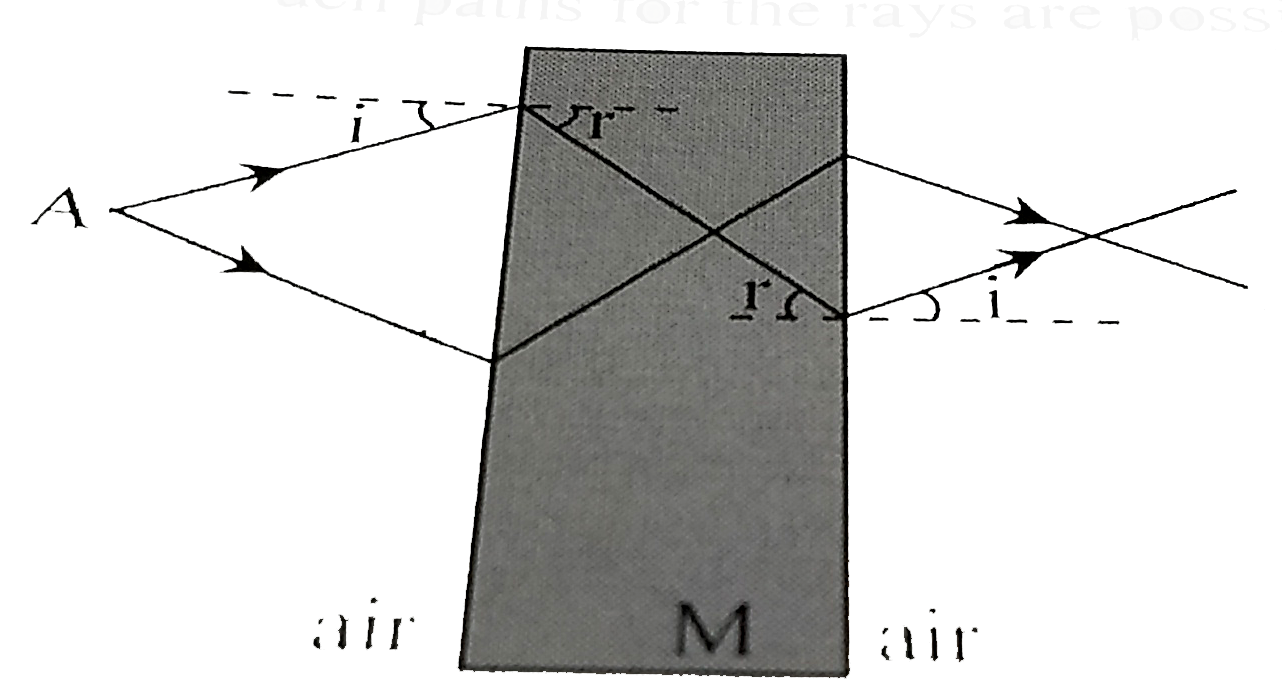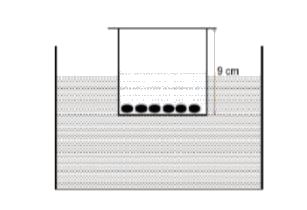Electromagnetic waves emanating from a point A (in air) are incident on a rectangular block of material M and emerge from the other side as shown. The angles i and r are angles of incidence and refraction when the wave travels from air to the medium. Such paths for the rays are possible

if the material has a refractive index very nearly equal to zero.
only with gamma rays with a wavelength smaller than the atomic nuclei of the material
if the material has a refractive index less than zero.
only if the wave travels in M with a speed faster than the speed of light in vacuum.
The correct Answer is:C
Step by step video, text & image solution for Electromagnetic waves emanating from a point A (in air) are incident on a rectangular block of material M and emerge from the other side as shown. The angles i and r are angles of incidence and refraction when the wave travels from air to the medium. Such paths for the rays are possible by Physics experts to help you in doubts & scoring excellent marks in Class 12 exams.
Topper's Solved these Questions
Similar Questions
A wide bottom cylindrical massless plastic container of height 9 cm has 40 identical coins inside it and is floating on water with 3 cm inside the water. If we start putting more of such coins on its lid. It is observed that after N coins are put, its equilibrium changes from stable to unstable. Equilibrium in floating is stable if the geometric center of the submerged portion is above the center of mass of the object) The value of N is closed to
 01:33View Solution
01:33View SolutionA ray of light is travelling from glass to air. The angle of incidence in glass is 35∘, and angle of refraction in air 60∘. What is the refractive index of glass w.r.t. air ?
01:34View SolutionA ray of light is travelling is travelling from air to water. What is the angle of incidence in air, if angle of refraction in water is 41^(@) ? Take refractive index of water = 1.32 .
03:23View SolutionGlass has refractive index μ with respect to air and the critical angle for a ray of light going from glass to air is θ. If a ray of light is incident from air on the glass with angle of incidence θ, the corresponding angle of refraction is
03:39View SolutionA light ray is travelling from air to glass. True reflected and refracted rays are perpendicular to each other. If the angle of incidence in air is I the refractive index of glass is
03:04View SolutionA ray of light travels from air to glass. It is found that the angle of refraction is half the angle of incidence. The the angle of incidence is given by
03:06View SolutionA ray of light travels from air to glass . It is found that the angle of refraction is half the angle of incidence . Then the angle of refraction is given by
View SolutionA ray of light travelling from air to glass is deviated by an angle of 24∘. If the reflected and refracted rays are at right angles then the angles of incidence is
04:38View SolutionThe ray of light travels from raer medium to denser medium of refractive index μ. The angle of incidence of twice the angle of refraction. The angle of incidence is given by
05:32View SolutionA ray of light travels from air to glass. It is found that the angle of refraction is half the angle of incidence. The the angle of incidence is given by
View SolutionA ray of light travels from air to glass, It is found that the angle of refraction is half the angle of incidence. Then the angle of refraction is given by:
View SolutionWhat happens to a light ray when it travels from air into water? Which angle is more angle of incidence or angle of refraction?
01:28View SolutionIf the angle of incidence is i and that of refraction is r . Then the speed of light in the medium to which the light is refracted from air is :
00:59View SolutionThe angle of incidence is always smaller than angle of refraction when a ray travels from air to glass. ______
02:39View SolutionDraw diagrams to show the refraction of light from (i) air to glass, and (ii) glass to air. In each diagram, label the incident ray, refracted ray, the angle of incidence (i) and the angle of refraction (r).
01:49View Solution

